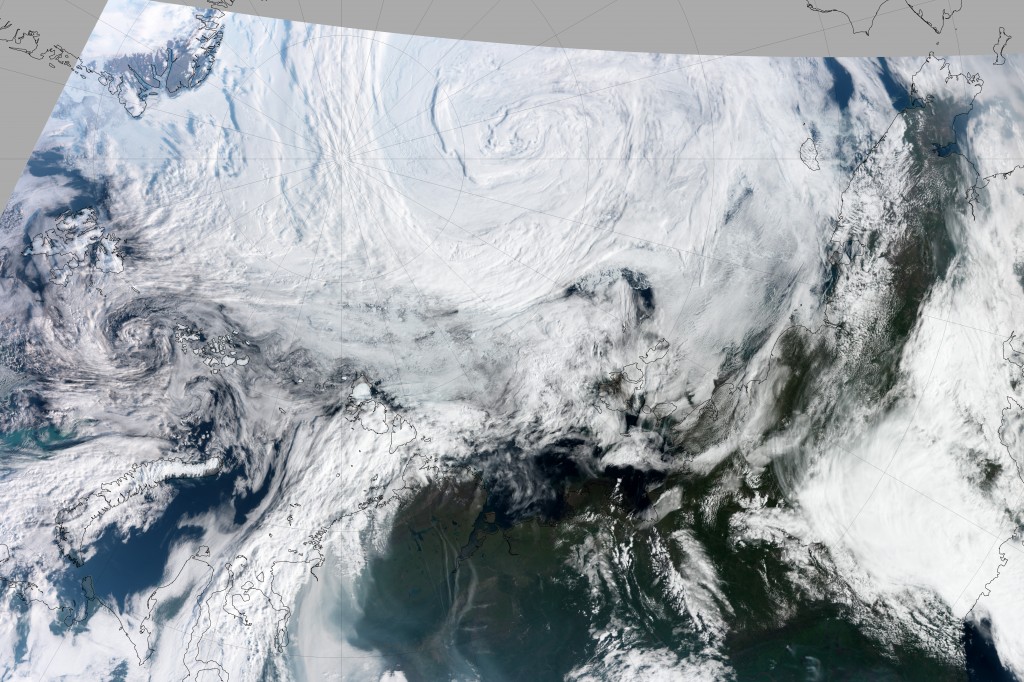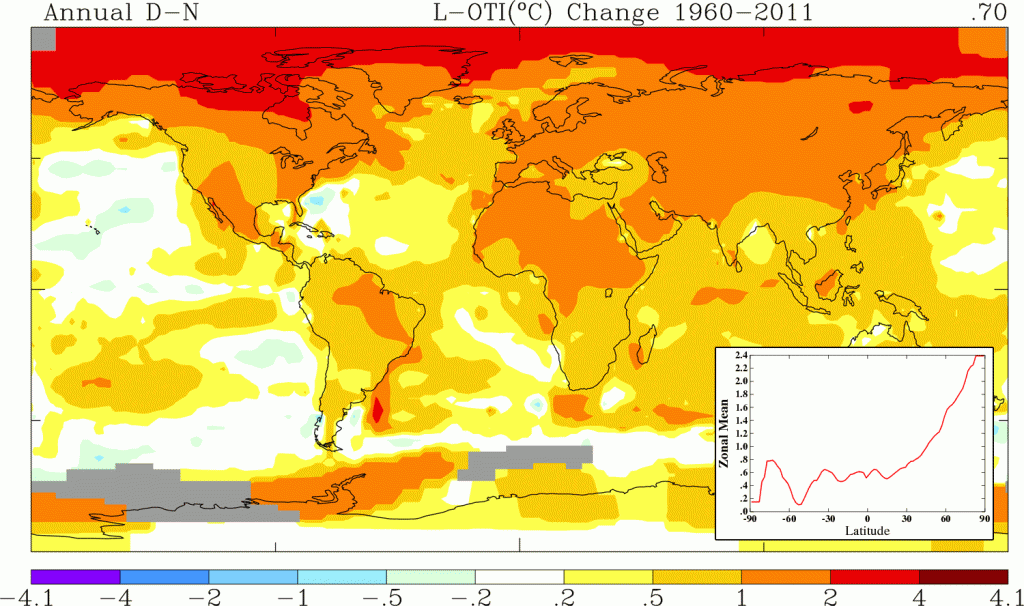Currently, there is a huge debate on the state of the Arctic and the concentration of sea ice over the area. Greenpeace are pushing for action on issues of future oil drilling, industrial fishing and the conflict that will undoubtedly ensue. But these are not the sole issues that need to be addressed. This blog will look at the impact of a changing Arctic, and the consequences of its declining sea ice levels on the climatology of the Arctic, northern hemisphere, and the world. An article published by NASA Earth Observatory, Strong Summer Cyclone Churns Over the Arctic, discusses the formation of “an unusually large, long-lasting, and powerful cyclone” in August 2012 that lasted 5 days – unlike the average 40 hours. Furthermore, the cyclone reached a sea level pressure of approximately 964 hPa, which is believed to be “more typical of a winter cyclone.” Image 1 shows the cyclone over the Arctic.

- Image 1: 2012’s summer cyclone over the Arctic (Allen & Simmon. 2012)
The article directly tackles the question of whether this cyclone was the result of climate change, stating that it may very well be influenced by it. This is because of an increased record of cyclones in the Arctic over the 2nd half of the 20th century. It was interesting to read that while the northern hemisphere as a whole will see a decline in extratropical cyclones in the future, “the Arctic Ocean and adjacent areas [will] see slightly more and stronger summer storms” (Voiland. 2012). If this is to be believed, these will surely affect the northern hemisphere, as sea ice and ocean and air temperatures change directly influencing cyclones in the Arctic. The article states, “Such changes may be providing more energy and moisture to support cyclone development and persistence” (Voiland. 2012).The article concludes with the acknowledgement that it is uncertain as to what exactly the affects of climate change will be on cyclone size, frequency, or trajectory, and that further research is very much needed. The changes that do occur however will have a large-scale affect on northern hemisphere climate.
“With reduced ice cover and warmer sea surfaces, the occurrence of more intense storms is certainly a plausible scenario. The limitation at present is the small sample size of exceptional events, but that may change in the future” (Voiland. 2012).
The National Snow and Ice Data Center (NSIDC. 2013) make a valid statement that is crucial to the debate on climate change in the Arctic. Sea ice changes in the Arctic have severe consequences on the global climate, because of the nature of the Arctic reflecting more heat and sunlight than it absorbs. Changes to the albedo of this region, will therefore increase global temperatures, as well as those for the Arctic region. Image 2 highlights the already evident trend of the changing Arctic climate. This further affects various feedback mechanisms. NSIDC argue that the positive feedback effects (called the Arctic amplification) are likely to outweigh the negative feedback effects. An example of the latter being “if warm temperatures make the Arctic growing season longer, more plants can survive and take up more carbon from the air,” thereby reducing “the amount of warming.”

- Image 2: Global mean surface air temperature for the period 1960 to 2011. The Arctic shows a 50-year trend of increasing air temperature greater than 2oC. “The inset shows linear trends over the period by latitude” (NSIDC. 2013)
This notion of changes in the Arctic having diverse affects on the northern hemisphere climatology is further supported by Overland and Wang, where they note that an increase in “summer Arctic open water areas” in the future will see “an increasing influence of [the] loss of summer sea ice on the atmospheric northern hemisphere general circulation in following seasons” (2010: 8). Francis et al. also support a changing Arctic to be indicative of global climate change: “Through its role in regulating the exchange of energy between the ocean and atmosphere, [Arctic] ice loss is anticipated to influence atmospheric circulation and weather patterns” (2009: 1). In conclusion, while Greenpeace are tackling vital issues that will follow changing Arctic sea ice extents, there is another more imminent problem that needs to be addressed right now. That of global climate change. Because once the Arctic is ice free enough to allow oil drilling, industrial fishing and conflict to occur, the northern hemisphere and global climate will already be influenced and irreversibly altered.
References:
- Allen, J. & Simmon, R. NASA Earth Observatory. 2012. Strong Summer Cyclone Churns Over the Arctic image. [Online]. Avialable: http://eoimages.gsfc.nasa.gov/images/imagerecords/78000/78808/arctic_vir_2012220_lrg.jpg (accessed 14 May 2013)
- Francis J. A., Chan W., Leathers D. J., Millar J. R., & Veron D. E. 2009. Winter Northern Hemisphere weather patterns remember summer Arctic sea-ice extent. Geophysical Research Letters, 36 (7): 1 – 5
- Greenpeace International. 2012. Save the Arctic. [Online]. Available: http://www.savethearctic.org/en (accessed 14 May 2013)
- NSIDC. 2013. Climate Change in the Arctic (NASA GISS image). [Online]. Available: http://nsidc.org/cryosphere/arctic-meteorology/climate_change.html (accessed 14 May 2013)
- Overland, J. E. & Wang, M. 2010. Large-scale atmospheric circulation changes are associated with the recent loss of Arctic sea ice. Tellus A, 62 (1): 1 – 9
- Voiland, A. NASA Earth Observatory. 2012. Strong Summer Cyclone Churns Over the Arctic. [Online]. Available: http://earthobservatory.nasa.gov/IOTD/view.php?id=78808 (accessed 14 May 2013)
Dean Harrison
It is often more frightening than not to observe the effects of climate change.
Although I do not dispute the need for climate change mitigation and the need to act now, we have already committed ourselves to a certain level of global warming over the next 20 years or so. Therefore, no matter how we attempt to mitigate against climate change, a reduced sea-ice Arctic might be inevitable. We need to accept the we have committed ourselves to a certain degree of climate change in order to prepare and adapt adequately. On the other hand , addressing climate change is a long term goal with no quick fixes. So while I agree that we need to act now, it should be noted that the benefits of these actions may only be noted decades down the line.
Not sure who said this but it is one of my favorite quotes:
” Expect the best but prepare for the worst “
Greg Dor
I have been reading quite a bit about this lately, in particular about the melting opening up new shipping routes and the Arctic to further exploration for oil. This seems like quite a big problem to me as increased traffic in the area will surely contribute to and exasperate the multitude of problems this area already faces. Oil companies campaigning for the right to drill in this area claim that they will do so with little damage, but just how minimal can this damage be kept to. I recently saw this flow diagram in the Guardian that depicts and explains just the impact they will have it quite nicely – http://www.guardian.co.uk/flash/0,5860,534962,00.html
Shakirudeen
This is REALLY interesting. I completely agree with you that there is need for an urgent action in addressing the alteration in global climate and northern hemisphere. I think the changing Arctic is an indication that the global climate is changing.
We should think of the numerous consequences of the changing Arctic and the sea ice and the impact it has on the earth’s process feedback.
Gemma, thank you for the information.